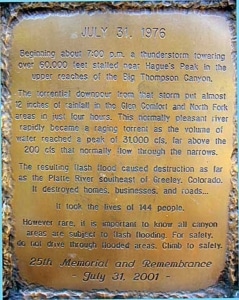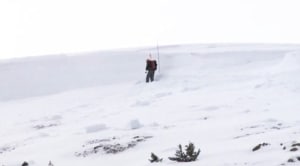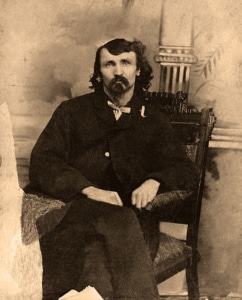DCPA NEWS CENTER
Enjoy the best stories and perspectives from the theatre world today.
Enjoy the best stories and perspectives from the theatre world today.
Real life survivor Margaret “Molly Brown” and Life of Pi’s fictional survivors Pi and Richard Parker (a Bengal tiger) have two things in common — both were adrift at sea following shipwrecks and both were, ultimately, destined for Colorado.
DCPA Broadway’s engagement of Life of Pi (March 18-30, 2025) recounts the extraordinary story of a 16-year-old boy who survives a shipwreck aboard a lifeboat with four unusual companions — a hyena, a zebra, an orangutan and a Bengal tiger. While Molly Brown did not have such companions, we’re pretty sure she would have remained “unsinkable” after 227 days at sea too.
But the show got us to wondering about other Colorado survival stories. Here are but a few examples of extraordinary fortitude, perseverance, and nerves of steel.
TOM TALLE RANCH — Blizzard of 1946
According to an account in TIME magazine, a blizzard swept across the Colorado plains for 48 hours in 1946, dumping as much as 50 inches of snow and leaving drifts that dwarfed the average man, leaving cattle for dead. But the ingenuous Manager of Tom Talle Ranch near Aroya rounded up three of the farmer’s iron horses to plow his way across the fields. According to the account, “a caterpillar tractor with a bulldozer blade was worth its weight in gold.” And the description was apt, as the farm managed to deliver 2,500 of its Hereford cattle to the market. While the Tom Talle Ranch may have been the most successful at saving its herd, other efforts were made including the delivery of hay bales via Army bombers to the Keystone Ranch near Karval, which led to an additional seven Army C-47s “hay bombing” and delivering supplies to stranded families.
TERRY BELAIR — Big Thompson Canyon Flood Survivor of 1976
The Big Thompson Canyon Flood of 1976 is considered the deadliest natural disaster in modern Colorado history. More than 3,500 people were in the area to celebrate the state’s 100th birthday when the sky ripped open, pummeling the canyon with 12 inches of rain in just over an hour — equivalent to the amount the arid state receives in an average year. More than 140 people lost their lives while thousands more were lucky to be alive, among them Terry Belair-Hassig. Terry and her friend Connie were driving home from Estes Park along U.S. 34 when the downpour began, obliterating the road. “Connie pulled over as far as she could,” Terry recalled in a 2017 Denver Post interview. “There were a few other cars in this section doing the same, but we all sat in our cars — planning to wait out the storm. However, once the river began to rise and the water was hitting the tires, we decided to leave the car and start climbing.” Armed with only a small flashlight and tarp, the two headed up the mountain, first stopping to wait out the storm on an exposed ledge from where they saw Connie’s car float away. “We decided at this point we should climb higher…. We sat on that little ledge (3 foot by 1 foot) with our knees drawn up to keep us from sliding off. We sang, shivered, cussed, and did anything we could to keep our minds off how cold and achy we were.” They waited out the night until being rescued by helicopter the following morning. According to 9News, “the flood also caused over $35 million in damages to 418 homes and businesses, 438 automobiles, bridges, paved and unpaved roads, mobile homes, powerlines and other structures.”
STORM KING MOUNTAIN FIREFIGHTERS — South Canyon Fire of 1994
On July 6, 1994, 14 wildland firefighters — Kathi Beck, Tamera Bickett, Scott Blecha, Levi Brinkley, Robert Browning, Doug Dunbar, Terri Hagen, Bonnie Holtby, Rob Johnson, Jon Kelso, Don Mackey, Roger Roth, Jim Thrash, and Richard Tyler — lost their lives as they fought to tame a quick-moving fire on Storm King Mountain during the South Canyon Fire in Glenwood Springs. Another 35 people including many firefighters were miraculously spared after taking refuge under fire-proof shelters or following an escape route out of the canyon. Among the survivors is Alex Robertson, then part of the Prineville Hotshots, a nationally shared wildland firefighting crew who traveled to Colorado to assist local firefighters. The lightning-induced fire spread rapidly due to dry conditions, low humidity, and strong winds up to 45 miles per hour. Firefighters came in from across the country to be faced with not only an out-of-control blaze, but steep, rugged terrain, 300-foot flames, and a fire spreading at 18 miles per hour. Ultimately, the fire lasted 10 days and covered 2,115 acres. Despite the tragic loss of life, the survivors — both those who worked the fire and their counterparts across the world — used the Storm King Mountain fire as a learning opportunity. “Their sacrifice that day, I do believe, has led to a lot of lives being saved because of lessons that we learned,” said Robertson who continued as a firefighter and currently works for the Forest Service in Central Oregon. Today, “remote automated weather station data is at your fingertips with a smartphone. Back then you relied on someone to gather the data and give it to you. Today a firefighter can just go get it.” Life-saving lessons learned at the expense of catastrophic loss.
JEROME BOULAY — Avalanche Survivor of 2013
A quick Google search of “Colorado avalanche survivor” returns a mountain of results. Refining that search to “deadliest Colorado avalanches in modern history” serves up years instead of instances. Twelve people lost their lives in 1987, 1992/93 and 2020/21. And then there was 2013, which reported 11 avalanche deaths…and one miraculous survival story. Jerome Boulay and five friends were participating in the Rocky Mountain High Backcounty Bash, ironically a benefit for the Colorado Avalanche Information Center. Suddenly, the mountain crumbled beneath their boards as an 800-foot-wide, 600-foot-long avalanche swept them down the mountain toward the Sheep Creek Gully. The snow completely buried Jerome’s friends. Luckily, Jerome’s lower left arm remained free, allowing him to sweep the snow away from his face so that he could breathe. With the entire group compromised, no one was left to call for help, leaving Jerome stranded until two avalanche forecasters spotted the slide and sent for help. Jerome was trapped for four hours until being freed. It was determined that the deep persistent slab avalanche was the worst since 1962, was large enough to destroy a car, and left at least one individual buried under up to 12 feet of snow. For avalanche forecasts and mountain weather conditions, visit Colorado Avalanche Information Center.

Alfred Packer
ALFRED PARKER — The “Colorado Cannibal” of 1874
No Colorado survival story would be complete without mention of the state’s most famous (or infamous) individual, Alfred Packer. As the story goes, this American prospector and self-proclaimed wilderness guide joined a group of 20 individuals who were determined to strike it rich. He offered to navigate them through the San Juan Mountains, just south of the then-Colorado territory. In attempting to follow the Spanish Trail toward Breckenridge, a heavy winter storm struck, hiding the path and stranding the men in the mountains. When they encountered a Ute encampment, Chief Ouray offered them food and shelter for the winter; however, 11 men chose to journey on despite the treacherous conditions. The smaller group ultimately separated with Packer joining five others through the San Juan Mountains toward the Los Pinós Indian Agency, which was 75 miles away. Sixty-five days later, Packer arrived alone at the Agency claiming starvation that his appearance did not reflect. He then spent lavishly, carried weapons that were “gifts” from his former companions, and pulled money from multiple wallets. When his former group members finally arrived at the Agency, they cast suspicion on Packer, his story, and his motivations. When asked by authorities as to the circumstances of his survival, he said,” It would not be the first time that people had been obliged to eat each other when they were hungry.” After several trips into the wilderness to investigate, authorities charged Packer with cannibalism. Ultimately, he confessed (though his story fluctuated over time), was found guilty (not once but twice), and was paroled after serving 18 years of a 40-year sentence. He died in 1907 at the age of 65 and was laid to rest in Littleton, Colorado. His story has become legend, inspiring books, restaurants, movies, and a musical by Trey Parker and Matt Stone of The Book of Mormon fame called Cannibal! The Musical.
